NVIDIA's G-Sync: Attempting to Revolutionize Gaming via Smoothness
by Anand Lal Shimpi on October 18, 2013 1:25 PM EST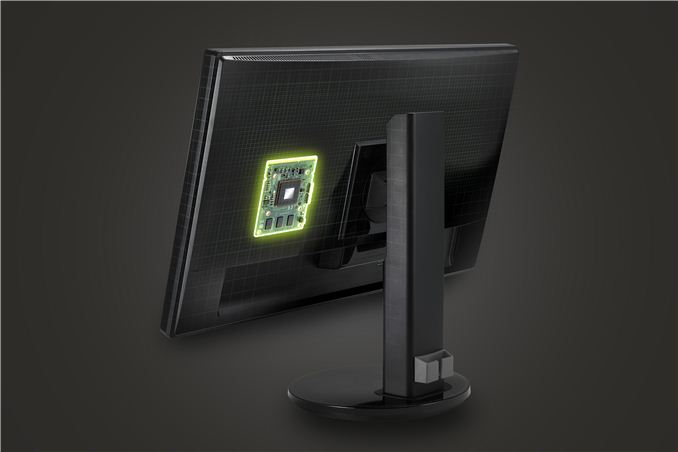
Earlier today NVIDIA announced G-Sync, its variable refresh rate technology for displays. The basic premise is simple. Displays refresh themselves at a fixed interval, but GPUs render frames at a completely independent frame rate. The disconnect between the two is one source of stuttering. You can disable v-sync to try and work around it but the end result is at best tearing, but at worst stuttering and tearing.
NVIDIA's G-Sync is a combination of software and hardware technologies that allows a modern GeForce GPU to control a variable display refresh rate on a monitor equipped with a G-Sync module. In traditional setups a display will refresh the screen at a fixed interval, but in a G-Sync enabled setup the display won't refresh the screen until it's given a new frame from the GPU.
NVIDIA demonstrated the technology on 144Hz ASUS panels, which obviously caps the max GPU present rate at 144 fps although that's not a limit of G-Sync. There's a lower bound of 30Hz as well, since anything below that and you'll begin to run into issues with flickering. If the frame rate drops below 30 fps, the display will present duplicates of each frame.
There's a bunch of other work done on the G-Sync module side to deal with some funny effects of LCDs when driven asynchronously. NVIDIA wouldn't go into great detail other than to say that there are considerations that need to be taken into account.
The first native G-Sync enabled monitors won't show up until Q1 next year, however NVIDIA will be releasing the G-Sync board for modding before the end of this year. Initially supporting Asus’s VG248QE monitor, end-users will be able to mod their monitor to install the board, or alternatively professional modders will be selling pre-modified monitors. Otherwise in Q1 of next year ASUS will be selling the VG248QE with the G-Sync board built in for $399, while BenQ, Philips, and ViewSonic are also committing to rolling out their own G-Sync equipped monitors next year too. I'm hearing that NVIDIA wants to try and get the module down to below $100 eventually. The G-Sync module itself looks like this:
There's a controller and at least 3 x 256MB memory devices on the board, although I'm guessing there's more on the back of the board. NVIDIA isn't giving us a lot of detail here so we'll have to deal with just a shot of the board for now.
Meanwhile we do have limited information on the interface itself; G-Sync is designed to work over DisplayPort (since it’s packet based), with NVIDIA manipulating the timing of the v-blank signal to indicate a refresh. Importantly, this indicates that NVIDIA may not be significantly modifying the DisplayPort protocol, which at least cracks open the door to other implementations on the source/video card side.
Although we only have limited information on the technology at this time, the good news is we got a bunch of cool demos of G-Sync at the event today. I'm going to have to describe most of what I saw since it's difficult to present this otherwise. NVIDIA had two identical systems configured with GeForce GTX 760s, both featured the same ASUS 144Hz displays but only one of them had NVIDIA's G-Sync module installed. NVIDIA ran through a couple of demos to show the benefits of G-Sync, and they were awesome.
The first demo was a swinging pendulum. NVIDIA's demo harness allows you to set min/max frame times, and for the initial test case we saw both systems running at a fixed 60 fps. The performance on both systems was identical as was the visual experience. I noticed no stuttering, and since v-sync was on there was no visible tearing either. Then things got interesting.
NVIDIA then dropped the frame rate on both systems down to 50 fps, once again static. The traditional system started to exhibit stuttering as we saw the effects of having a mismatched GPU frame rate and monitor refresh rate. Since the case itself was pathological in nature (you don't always have a constant mismatch between the two), the stuttering was extremely pronounced. The same demo on the g-sync system? Flawless, smooth.
NVIDIA then dropped the frame rate even more, down to an average of around 45 fps but also introduced variability in frame times, making the demo even more realistic. Once again, the traditional setup with v-sync enabled was a stuttering mess while the G-Sync system didn't skip a beat.
Next up was disabling v-sync with hopes of reducing stuttering, resulting in both stuttering (still refresh rate/fps mismatch) and now tearing. The G-Sync system, once again, handled the test case perfectly. It delivered the same smoothness and visual experience as if the we were looking at a game rendering perfectly at a constant 60 fps. It's sort of ridiculous and completely changes the overall user experience. Drops in frame rate no longer have to be drops in smoothness. Game devs relying on the presence of G-Sync can throw higher quality effects at a scene since they don't need to be as afraid of drops in frame rate excursions below 60 fps.
Switching gears NVIDIA also ran a real world demonstration by spinning the camera around Lara Croft in Tomb Raider. The stutter/tearing effects weren't as pronounced as in NVIDIA's test case, but they were both definitely present on the traditional system and completely absent on the G-Sync machine. I can't stress enough just how smooth the G-Sync experience was, it's a game changer.
The combination of technologies like GeForce Experience, having a ton of GPU performance and G-Sync can really work together to deliver a new level of smoothness, image quality and experience in games. We've seen a resurgence of PC gaming over the past few years, but G-Sync has the potential to take the PC gaming experience to a completely new level.
Update: NVIDIA has posted a bit more information about G-Sync, including the specs of the modified Asus VG248QE monitor, and the system requirements.
| NVIDIA G-Sync System Requirements | |||||||||
| Video Card | GeForce GTX 650 Ti Boost or Higher | ||||||||
| Display | G-Sync Equipped Display | ||||||||
| Driver | R331.58 or Higher | ||||||||
| Operating System | Windows 7/8/8.1 | ||||||||


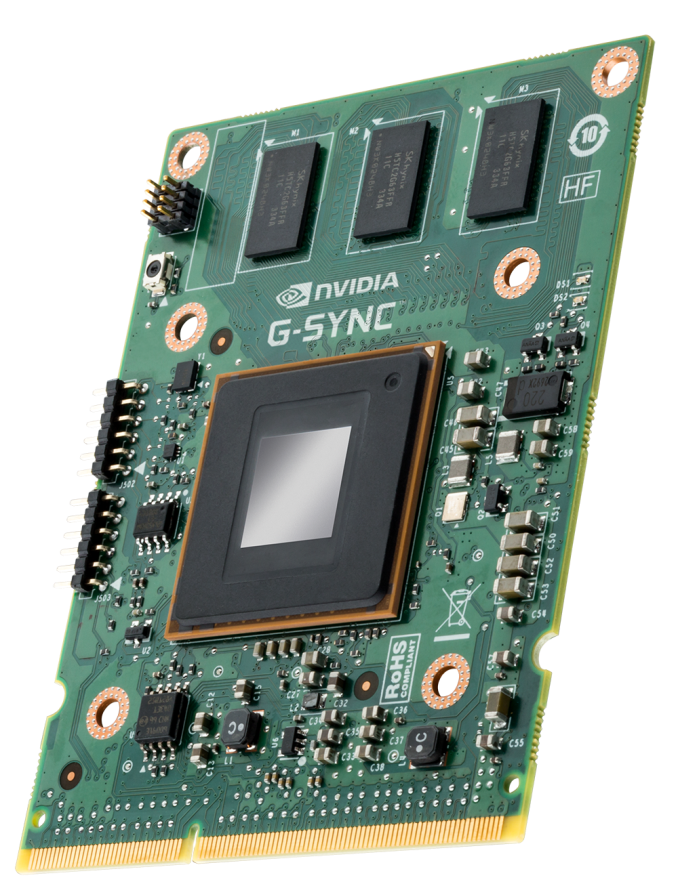
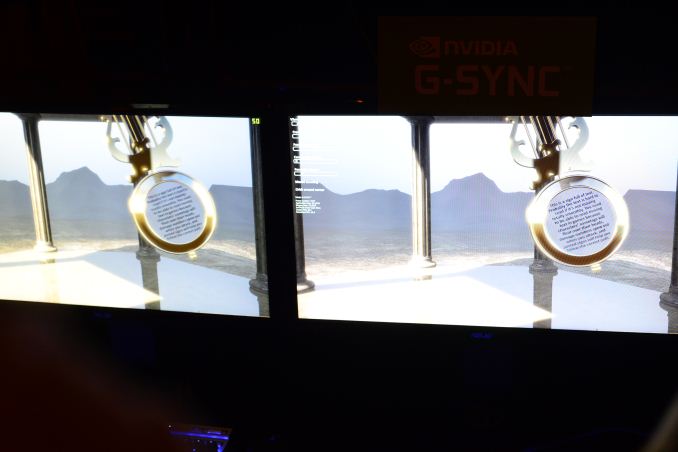
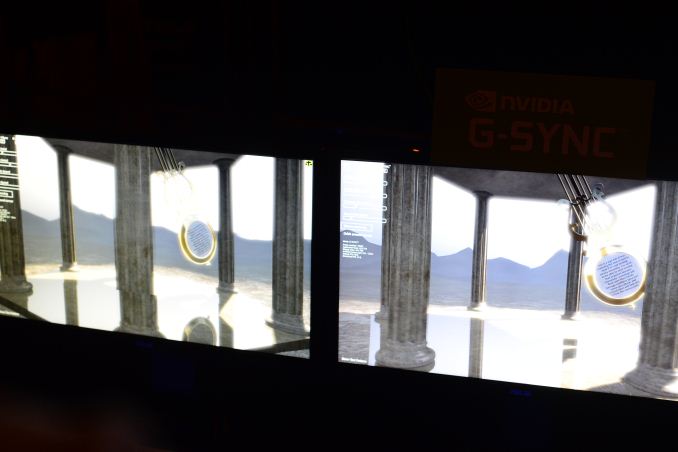
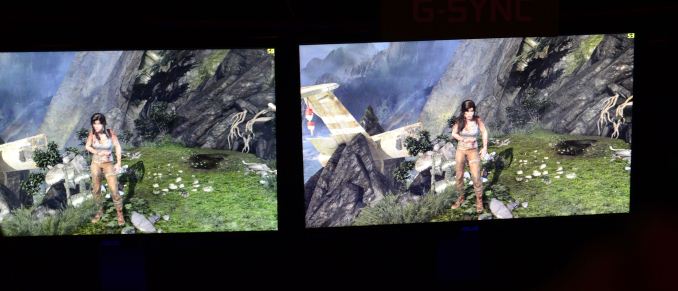
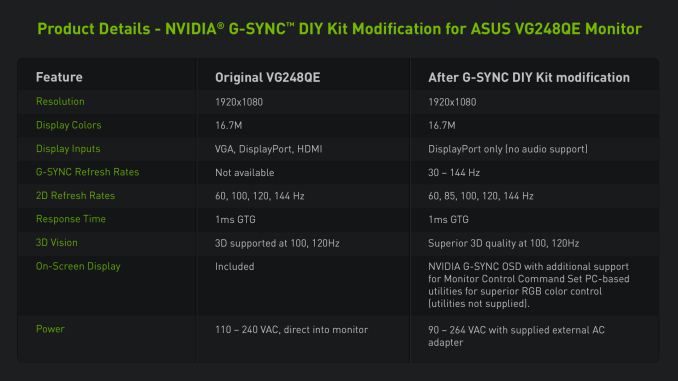








217 Comments
View All Comments
Soulwager - Sunday, October 20, 2013 - link
I think the memory is for PSR below 30fps, if they were interpolating frames they'd just do it GPU side.mdrejhon - Monday, October 21, 2013 - link
G-SYNC does not use interpolation.The ghosting effect is simply a side effect of framerate.
Motion blur is directly proportional to framerate on flickerfree LCD displays (non-strobe mode).
Seeing http://www.testufo.com -- Notice how 30fps has more motion blur than 60fps (and if you're using a 120Hz monitor), how 60fps has more motion blur than 120fps.
With G-SYNC, motion blur gradually ramps up/down instead of you seeing stutters.
wojtek - Tuesday, October 22, 2013 - link
It also shows how lower framerate always produces relative shift back to higer framerate despite of actual sync (in this case sync is perfect because 30 divides 60). Take it into account when you talking about object position on screen relative to sync.mdrejhon - Thursday, October 24, 2013 - link
Yes, with G-SYNC, everything is always matched to refresh rate. 45fps@45Hz, 67fps@67Hz, etc. Varying framerates now always looks like framerate=Hz, provided screen object position corresponds to real time. (to stay in sync with eye tracking position)Eye tracking diagrams for G-SYNC are found at:
http://www.blurbusters.com/gsync/how-does-gsync-fi...
Veroxious - Monday, October 21, 2013 - link
Yeah like I am going to risk that amount of cash on a new GPU and G-Sync enabled monitor when nobody has a clue on what the adoption rate would be. The cost is simply prohibitive and foolish of Nvidia. Also there is no mention of what cards will support this. I'm all for smoother gaming but the vast majority of us gamers have limited budgets. That is a serious chunk of GPU budget . In single card configs I buy whatever gives me the best bang for the buck be it green or red. If the monitors were priced the same then it would be a game changer. For what it is worth, stutter has never been an issue for for me on either platforms and on the rare occasions it has occurred it did not spoil the experience for me. As long as I can game at 1080p with medium to high settings I am a happy camper period.polaco - Monday, October 21, 2013 - link
well I don't blame you, I think the same. Why on earth should I spend that amount of money to get no stuttering that is only noticed on a freezed screen test? when would I want to read text on a moving pendulum? the demo done with tomb rider show little benefits. I prefer to invest in a better gpu or cpu since will make me play at decent frame rates and will make my investment to last more. This G-sync feature is totally hyped!Kookaburra8su - Wednesday, October 30, 2013 - link
Agreed, double dip expense.There was a company called Hi-Toro that developed patents for frame rate/refresh matching from graphics processor to monitor/TV Hz rate in the 1980's.
This Nvidia tech is ass about.
jasonelmore - Monday, October 21, 2013 - link
I wish i knew if the 27" Asus Version of this screen (ASUS VG278HE) will support the add-on card. I'd rather have the larger screen and they are both 144hzToblerone - Friday, October 25, 2013 - link
This is great.Please stop making things like this proprietary. Create an industry standard with AMD and Intel so it can gain mass adoption.
Kookaburra8su - Wednesday, October 30, 2013 - link
This whole concept is ass about, there is no need for this tech. Process scene, send at frame rate processed, capture, reprocessing for new frame rate, dispay - to much double handling, and a waste energy. It's like having a graphics card in 2 parts, and having pay twice to get both. Easier to process, match frame rate of monitor, send to monitor. Lots cheaper too.These refresh issues have been solved before, by having the graphics processor match the referesh rate of the monitor. Build a variable version into todays graphics cards and you can output smooth frame rates to any monitor out there today, no need to buy a new monitor, no need to buy Nvidia hardware twice.
Unfortunately for Nvidia, I don't believe the patents for refresh matching from graphic processor to monitor are owned by them. It was developed by a tech company that matched their graphics processor to the Hz rate of tv's in the 1980's. I remember it was company called Hi-Toro.
Anyone know who owns those patents now?